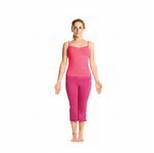Tadasana (Mountain Pose)
Benefits
|
It teaches the art of standing correctly and counters the degenerative effects of aging on the spine, legs and feet. It overcomes bad posture by bringing awareness to the body and by teaching correct alignment of the spine. It creates space within the body, thus allowing organs to work efficiently and undoes any compression that may have occurred in the prior yoga pose if done correctly. In addition to the physical benefits on the musculoskeletal system and organs, it also leaves the yoga practitioner invigorated, alert and centered. This is the perfect pose for an early morning yoga session and for the yoga practitioner to begin from and return to after each standing pose. |
 |
First Stage
|
We begin Tadasana with the the base of your big toes touching and heels slightly apart. Next spread your toes apart and lay them down on the floor. To achieve a sense of balance, rock from side to side and gradually reduce swaying. Without engaging the lower belly, lift the knee caps and firm the thigh muscles. Turn the upper thighs inward and imagine a line of energy going through the center of your body. |
Second Stage
|
Press shoulder blades in and then release them down your back. Widen your collarbones by hanging your arms beside the torso. Keep your head centered with your chin parallel to the floor. Soften your throat, tongue and eyes. |
 |
In the Pose
This pose is used as a base for all standing poses. If practiced alone, hold for 30-60 seconds and then release.
Practice Notes
Beginners may want to start with their feet spread slighlty farther apart to improve balance. To deepen the pose, close your eyes and practice balancing without outside reference points.
Contraindications and Cautions
If you have headaches, suffer from isomnia or low blood pressure use caution.


